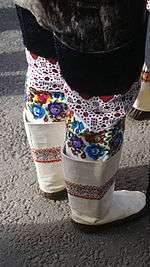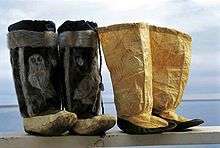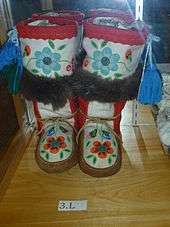Mukluk

Mukluks or Kamik (ᑲᒥᒃ [kaˈmik][1]) (singular: kamak, plural: kamiit) are a soft boot traditionally made of reindeer (caribou) skin or sealskin and were originally worn by Arctic aboriginal people, including the Inuit and Yupik. The term mukluk is often used for any soft boot designed for cold weather and modern designs are often similar to high-top athletic shoes. The word "mukluk" is of Yupik origin, from maklak, the bearded seal, while "kamik" is an Inuit word. In the Inuipiaq language the "u" makes an "oo" sound, and so the spelling "maklak" is used with the same pronunciation.


Another type of boot, sometimes called an Inuit boot, originating in Greenland and the eastern part of Alaska, are made by binding them with animal cartilage and have a centre seam running down to the foot of the boot.
Mukluks weigh little and allow hunters to move very quietly. They may be adorned with pompons and beads and may be lined with furs such as rabbit, fox and raccoon.
The design of the mukluk is used for the industrial manufacture of cold-weather boots, especially paired with a rugged contemporary sole. The key component of its success is its ability to breathe, that is, to allow air exchange. This is an advantage in extremely cold conditions where perspiration may become a factor in frostbite on one's feet. The bulkiness paired with their poor performance in slush makes them less ideal for the casual winter wearer.[2]
Another kind of mukluk, typically made out of wool or a wool-rayon blend, is knitted with a soft leather sole. Often called "Slipper Socks", these were the traditional mukluk worn by the people of the Hindu Kush Mountains.
See also
References
| Look up mukluk or kamik in Wiktionary, the free dictionary. |